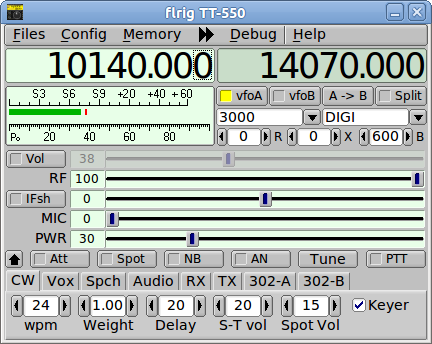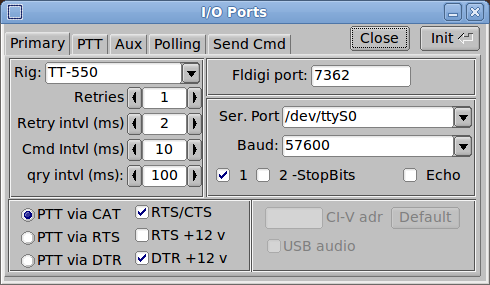 |
flrig_help
2.0.04
|
 |
flrig_help
2.0.04
|

FLRIG provides a full implementation of all TT550 control functions including the operation of the Model 302 remote keypad. The TT550 selection can also be used with the TT538, Jupiter. The Jupiter emulates all of the Pegasus commands.
All of the FLRIG "front panel" controls operate the same as for any other transceiver with a few exceptions. The Pegasus does not have any preamp control. So that button is converted for use as a spot control when the rig is in CW mode.
Select CW mode and then press the spot button. You should hear the sidetone (if not you may need to increase the Spot Vol ... see below). You can then adjust the B (BFO) control for the desired sidetone frequency.
The DIGI mode is unique to FLRIG and the TT550. The control commands available on the Pegasus allow the program to control the center frequency and the bandwidth for all of the DSP filters. The DIGI mode is designed to always place the center frequency of the filter at 1500 Hz. When FLRIG is used with FLDIGI this provides a very convenient and easy way to QSY to a received signal and then narrow down the filter. The Pegasus DSP filters are very well suited to digital mode operations.

Selecting the TT550 from the rig selection combo box should preset all of the interface controls. You should only need to select from the serial port combo. FLRIG will find all unused serial ports so be sure that the TT550 is not being accessed by another software when you start FLRIG.
It is necessary to press the Init button when you first set the program for use with a transceiver. Subsequent use should not require any action on the part of the operator.
The TT550 has it's own set up dialog for accessing those controls that are not routinely used. This dialog is opened by the "Config / Xcvr setup" menu.
Access to the additional controls is obtained by the down arrow button to the left of the Att control.

The internal keyer can be enabled and both the words/min and the weight of the keyer can be adjusted. The Pegasus is a QSK rig and you can adjust the QSK hold in milliseconds. You can adjust the keyer sidetone volume relative to the received audio. Set the control to zero if you do want to hear the sidetone. The Spot Vol control is associated with the Spot button on the front panel. This volume is also relative to the receiver volume control.

You can operate the Pegasus with manual SSB PTT or with Vox. The three Vox controls are controlled IAW the 550 manual.

You can monitor the SSB speech level (recommended only with headphones). The compression level is also adjustable and speech compression can be enabled or disabled as suited.
The Accessory socket line out level can be set to prevent overdriving of a terminal node controller or computer sound card interface. The front panel NB, noise blanker, control can be set for any level from NONE to

Audio can be either from the Mic connector or from the Accessory input (digital mode ops). The level of the line out on the remote connector can be controlled independent of the speaker.

The signal frequencies internal to the Pegasus are all derived from a single oscillator. That oscillator can be corrected for frequency error using the VFO adjustment control.

The signal frequencies internal to the Pegasus are all derived from a single oscillator. That oscillator can be corrected for frequency error using the VFO adjustment control.

302 Keypad Accessory If you have the 302 keypad you can set various parameters to adjust it's performance. The function keys can be assigned on of several response functions:

Both the Pegasus and the Jupiter can be controlled with the Model 302 key pad / encoder.
As you enter keypad values from the keypad they will appear in an entry box at the upper right of the main dialog. These are used for entering a frequency in kHz (i.e. 14.070 MHz is entered as 14070.000). You can abort the input by pressing the decimal value twice in succession.